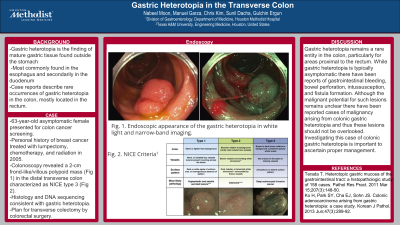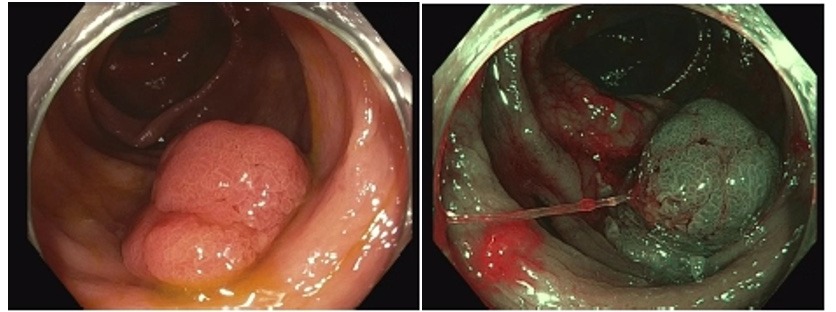Sunday Poster Session
Category: Colon
P0272 - Gastric Heterotopia in the Transverse Colon
Sunday, October 22, 2023
3:30 PM - 7:00 PM PT
Location: Exhibit Hall

Has Audio

Nabeel Moon, MD
Houston Methodist Hospital
Houston, TX
Presenting Author(s)
Nabeel Moon, MD1, Manuel Garza, MD2, Christopher Kim, MD1, Sunil Dacha, MD1, Gulchin A. Ergun, MD1
1Houston Methodist Hospital, Houston, TX; 2Baylor Scott & White Medical Center, Round Rock, TX
Introduction: Gastric heterotopia is the finding of mature gastric tissue found outside the stomach. It is most commonly found in the esophagus and secondarily in the duodenum. There are case reports that describe rare occurrences of gastric heterotopia in the colon, mostly located in the rectum. There have been only 9 reported cases involving the colon proximal to the rectum. Here we present the case of a 63-year-old female who was found to have gastric heterotopia in the transverse colon.
Case Description/Methods: A 63-year-old asymptomatic female presented to clinic for colon cancer screening. She had a history of breast cancer treated with lumpectomy, chemotherapy, and radiation in 2005. Her colonoscopy revealed a 2-cm frond-like/villous polypoid and ulcerated non-obstructing mass arising from a diverticulum in the distal transverse colon. The mass was endoscopically characterized as type 3 by the NICE criteria. Given the endoscopic appearance and history of breast cancer with concern for a potential metastatic lesion, the mass was biopsied instead of resected, and a tattoo was placed distally. Pathology revealed gastric epithelium and glands. Special testing for short tandem repeats was performed comparing DNA in these biopsies with DNA from previous esophageal and gastro-esophageal junction biopsies, confirmed the polyp was gastric in nature, supporting gastric heterotopia. She had repeat colonoscopy by interventional endoscopy team for possible removal, but the mass was adjacent to a diverticulum, therefore, deemed too risky for removal and repeat biopsies were taken. Again, this revealed gastric mucosa with gastric foveolar lining columnar cells, parietal cells, and chief cells, consistent with gastric heterotopia. She was referred for surgical evaluation for resection to prevent future complications such as perforation, intussusception, and fistula formation.
Discussion: Gastric heterotopia remains a rare entity in the colon, particularly for areas proximal to the rectum. While gastric heterotopia is typically asymptomatic there have been reports of gastrointestinal bleeding, bowel perforation, intussusception, and fistula formation. Although the malignant potential for such lesions remains unclear there have been reported cases of malignancy arising from colonic gastric heterotopia and thus these lesions should not be overlooked. Investigating this case of colonic gastric heterotopia is important to ascertain proper management.

Disclosures:
Nabeel Moon, MD1, Manuel Garza, MD2, Christopher Kim, MD1, Sunil Dacha, MD1, Gulchin A. Ergun, MD1. P0272 - Gastric Heterotopia in the Transverse Colon, ACG 2023 Annual Scientific Meeting Abstracts. Vancouver, BC, Canada: American College of Gastroenterology.
1Houston Methodist Hospital, Houston, TX; 2Baylor Scott & White Medical Center, Round Rock, TX
Introduction: Gastric heterotopia is the finding of mature gastric tissue found outside the stomach. It is most commonly found in the esophagus and secondarily in the duodenum. There are case reports that describe rare occurrences of gastric heterotopia in the colon, mostly located in the rectum. There have been only 9 reported cases involving the colon proximal to the rectum. Here we present the case of a 63-year-old female who was found to have gastric heterotopia in the transverse colon.
Case Description/Methods: A 63-year-old asymptomatic female presented to clinic for colon cancer screening. She had a history of breast cancer treated with lumpectomy, chemotherapy, and radiation in 2005. Her colonoscopy revealed a 2-cm frond-like/villous polypoid and ulcerated non-obstructing mass arising from a diverticulum in the distal transverse colon. The mass was endoscopically characterized as type 3 by the NICE criteria. Given the endoscopic appearance and history of breast cancer with concern for a potential metastatic lesion, the mass was biopsied instead of resected, and a tattoo was placed distally. Pathology revealed gastric epithelium and glands. Special testing for short tandem repeats was performed comparing DNA in these biopsies with DNA from previous esophageal and gastro-esophageal junction biopsies, confirmed the polyp was gastric in nature, supporting gastric heterotopia. She had repeat colonoscopy by interventional endoscopy team for possible removal, but the mass was adjacent to a diverticulum, therefore, deemed too risky for removal and repeat biopsies were taken. Again, this revealed gastric mucosa with gastric foveolar lining columnar cells, parietal cells, and chief cells, consistent with gastric heterotopia. She was referred for surgical evaluation for resection to prevent future complications such as perforation, intussusception, and fistula formation.
Discussion: Gastric heterotopia remains a rare entity in the colon, particularly for areas proximal to the rectum. While gastric heterotopia is typically asymptomatic there have been reports of gastrointestinal bleeding, bowel perforation, intussusception, and fistula formation. Although the malignant potential for such lesions remains unclear there have been reported cases of malignancy arising from colonic gastric heterotopia and thus these lesions should not be overlooked. Investigating this case of colonic gastric heterotopia is important to ascertain proper management.

Figure: Endoscopic appearance of the gastric heterotopia in white light and narrow-band imaging.
Disclosures:
Nabeel Moon indicated no relevant financial relationships.
Manuel Garza indicated no relevant financial relationships.
Christopher Kim indicated no relevant financial relationships.
Sunil Dacha indicated no relevant financial relationships.
Gulchin Ergun indicated no relevant financial relationships.
Nabeel Moon, MD1, Manuel Garza, MD2, Christopher Kim, MD1, Sunil Dacha, MD1, Gulchin A. Ergun, MD1. P0272 - Gastric Heterotopia in the Transverse Colon, ACG 2023 Annual Scientific Meeting Abstracts. Vancouver, BC, Canada: American College of Gastroenterology.
